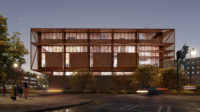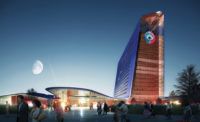In November, TArch—the research laboratory of the Venice-based architecture firm TA Office—publicly launched a research project investigating the intersection of neuroscience and architecture by tracking human emotional responses to the built environment.
Neurologist Vittorio Gallese, physiology professor at the University of Parma in Italy and adjunct senior research scholar in Columbia University’s department of art and art history, and Davide Ruzzon, founder and director of TA Office, are co-curating the crowd-funded study, called ROOMS, which will assess observers’ emotional responses to images of airport lounges, classrooms, hospital rooms, and assembly halls.

“Aesthetic experience is crucial for cognitive neuroscience because it provides an ideal way of studying the variety of worlds we inhabit,” says Gallese. Beginning January 1, ROOMS will collect standardized black-and-white photographs of spaces from architects and designers across the globe. After selecting 40 depicted spaces, an assortment of individuals—including design professionals, laypeople, and 15 regular users of each space—will take an online test, answering five questions in rapid succession immediately after viewing the images.
With help from a board of scientific advisors, Gallese and Ruzzon will analyze the results and later release their findings. Projects like ROOMS belong to a growing field of interest, says Meredith Banasiak, M.Arch., EDAC, a senior instructor with the University of Colorado’s environmental design program who studies the connection among the built environment, body, and brain through the lens of cognitive science. “In the last 10 years, a lot more evidence-based research has shown strong relationships between the environment and brain and behavior,” she says.
Margaret R. Tarampi, Ph.D. (psychology), B.Arch., a research associate at the Center for Spatial Studies at University of California, Santa Barbara, has also noticed increased activity in this emerging multidisciplinary field. “It’s taken a while to be something researchers take up,” she says, “but we’re finally getting to a critical mass where both scientists and architects are asking how the built environment influences us. This kind of research can be a tool for architects to use.”
Findings from cognitive science projects that focus on architecture—including TArch’s ROOMs—could inform design decisions in significant ways, much as past studies have shown the presence of natural light and nature to improve patient outcomes in hospitals. “If we can choreograph sensory experiences more precisely,” says Banasiak, “knowing how the environment affects people’s emotions and physiological responses, like heart rate and stress levels—which, in turn, affect cognition and performance—then we can optimize health, comfort, and productivity.”







Post a comment to this article
Report Abusive Comment